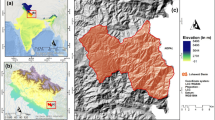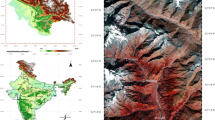Abstract
Any errors in digital elevation models (DEMs) will introduce errors directly in gravity anomalies and geoid models when used in interpolating Bouguer gravity anomalies. Errors are also propagated into the geoid model by the topographic and downward continuation (DWC) corrections in the application of Stokes’s formula. The effects of these errors are assessed by the evaluation of the absolute accuracy of nine independent DEMs for the Iran region. It is shown that the improvement in using the high-resolution Shuttle Radar Topography Mission (SRTM) data versus previously available DEMs in gridding of gravity anomalies, terrain corrections and DWC effects for the geoid model are significant. Based on the Iranian GPS/levelling network data, we estimate the absolute vertical accuracy of the SRTM in Iran to be 6.5 m, which is much better than the estimated global accuracy of the SRTM (say 16 m). Hence, this DEM has a comparable accuracy to a current photogrammetric high-resolution DEM of Iran under development. We also found very large differences between the GLOBE and SRTM models on the range of −750 to 550 m. This difference causes an error in the range of −160 to 140 mGal in interpolating surface gravity anomalies and −60 to 60 mGal in simple Bouguer anomaly correction terms. In the view of geoid heights, we found large differences between the use of GLOBE and SRTM DEMs, in the range of −1.1 to 1 m for the study area. The terrain correction of the geoid model at selected GPS/levelling points only differs by 3 cm for these two DEMs.
Similar content being viewed by others
References
Abbolgasem A (1994) Iranian sea surface topography. MSc Thesis, K.N. Toosi University, Tehran
Ågren J (2004) Regional geoid determination methods for the era of satellite gravimetry. PhD Thesis, Royal Institute of Technology, Stockholm, Sweden
Ardalan AA, Grafarend EW (2004) High resolution geoid computation without applying Stokes’s formula case study: high resolution geoid of Iran. J Geod 78:138–156
Forsberg R (1985) Gravity field terrain effect computations by FFT. Bull Geod 59:342–360
Fotopoulos G, Kotsakis C, Sideris MG (2003) How accurately can we determine orthometric height differences from GPS and geoid data? Simulated case studies in Western Canada. J Surv Eng 129(1):1–10
Hamesh M (1991) Technical report about adjustment of Iranian first order levelling network, National Cartographic Centre of Iran. J Surveying 1:9–20
Hamesh M, Zomorrodian H (1992) Iranian gravimetric geoid determination second step, National Cartographic Centre of Iran. J Surv 6:17–24, 52–63
Hastings DA, Dunbar PK (1999) Global land one-kilometer base elevation (GLOBE): NGDC key to geophysical records documentation No 34. National Geophysical Data Center, Boulder, Colorado, p 138
Heiskanen WA, Moritz H (1967) Physical geodesy. Freeman, San Francisco
Hilton RD, Featherstone WE, Berry PAM, Johnson CPD, Kirby JF (2003) Comparison of digital elevation models over Australia and external validation using ERS-1 satellite radar altimetry. Aust J Earth Sci 50:157–168
Kiamehr R, Sjöberg LE (2005) The qualities of Iranian gravimetric geoid models versus recent gravity field missions. Studia Geophysica et Geodaetica 49:289–304
Kiamehr R (2005) Qualification and refinement of the Iranian gravity database. In: Proceedings of the National Cartographic Center of Iran Geomatics 84 Conferences, Tehran
Kotsakis C, Sideris MG (1999) On the adjustment of combined GPS/levelling/geoid networks. J Geod 73(8):412–421
Lemoine FG, Kenyon SC, Factor JK, Trimmer RG, Pavlis NK, Chinn DS, Cox CM, Klosko SM, Luthcke SB, Torrence MH, Wang YM, Williamson RG, Pavlis EC, Rapp RH, Olson TR (1998) The development of the joint NASA GSFC and the National Imagery and Mapping Agency (NIMA) Geopotential Model EGM96, NASA/TP-1998–206861. Goddard Space Flight Center, Greenbelt
Merry CL (2003) DEM-induced errors in developing a quasi-geoid model for Africa. J Geod 77:537–542
Najafi M (2004) New Iranian geoid model using Stokes-Helmert approach. Tech report. National Cartographic Centre of Iran, Tehran
Tscherning CC, Knudsen P, Forsberg R (1994) Description of the GRAVSOFT package. Geophysical Institute, University of Copenhagen, Technical report, 1991, 2nd edn, 1992, 3rd edn, 1993, 4th edn
Sandwell DT, Smith WHF (1997) Marine gravity anomaly from Geosat and ERS 1 satellite altimetry. J Geophys Res 102(B5):10039–10054
Sjöberg LE (1991) Refined least squares modification of Stokes’s formula. Manuscr Geod 16:367–375
Sjöberg LE (2003) A computational scheme to model the geoid by the modified Stokes formula without gravity reductions. J Geod 77:423–432
US Geological Survey (1997) GTOPO30 digital elevation model. US Geological Survey
Author information
Authors and Affiliations
Corresponding author
Rights and permissions
About this article
Cite this article
Kiamehr, R., Sjöberg, L.E. Effect of the SRTM global DEM on the determination of a high-resolution geoid model: a case study in Iran. J Geodesy 79, 540–551 (2005). https://doi.org/10.1007/s00190-005-0006-8
Received:
Accepted:
Published:
Issue Date:
DOI: https://doi.org/10.1007/s00190-005-0006-8




